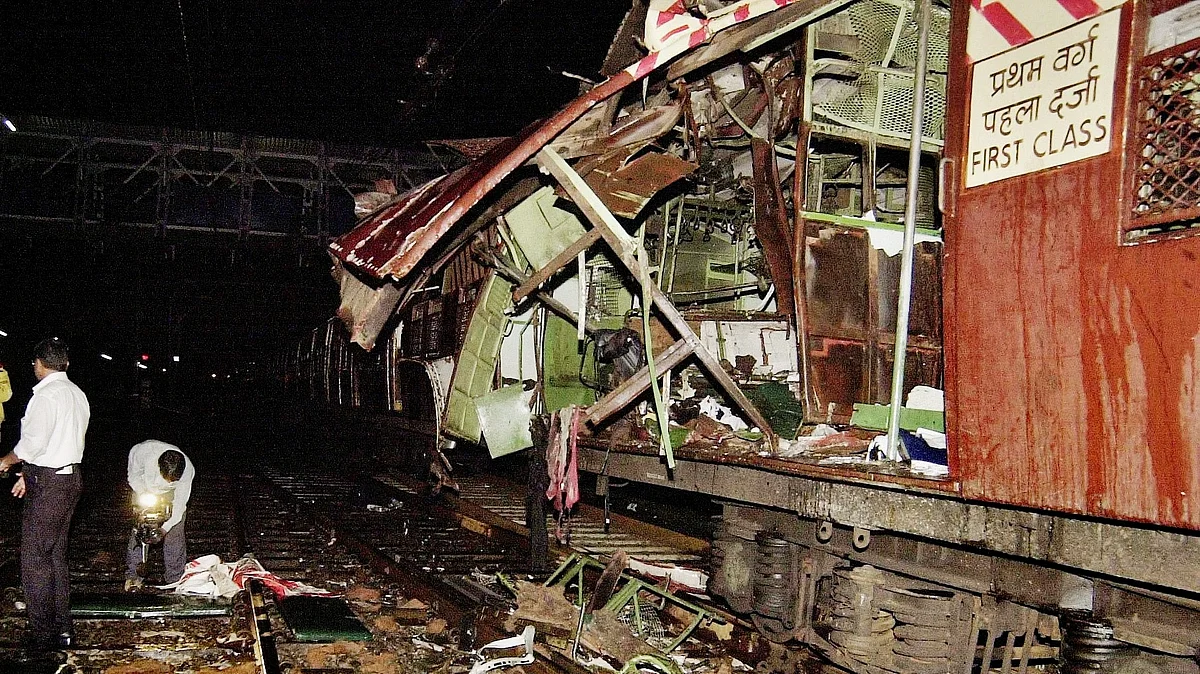Maharashtra: A jolt of a judgement
In the Mumbai train blasts case, judges recorded that the culprits still roam free and no one knows who committed the crime

Seven serial blasts ripped through seven Mumbai local trains between 6.23 pm and 6.29 pm on 11 July 2006, killing 187 people and injuring over 800. The ghastly crime targeted Mumbai’s lifeline that ferries more than 6 million people daily in India’s financial centre.
But a shocker of a different kind came on 21 July this year — 19 years later — when a division bench of the Bombay High Court ruled that the case in effect remains unsolved and the ‘true threat remains at large’. The HC acquitted all the 12 accused in the case, including five who had been awarded the death penalty by the trial court, and recorded strong observations against the police for gross mishandling of the investigation.
The division bench of Justices Anil Kilor and Shyam Chandak opened the 667-page judgement with the following words: ‘...creating a false appearance of having solved a case by presenting that the accused have been brought to justice gives a misleading sense of resolution. This deceptive closure undermines public trust and falsely reassures society while, in reality, the true threat remains at large.’
In effect, the judges recorded that the culprits still roam free and no one knows who committed the crime. Some innocents were tortured and presented as the killers, but the elaborate story did not stand scrutiny.
The scathing remarks of the Bombay High Court not only brought shame and ignominy to the investigating agencies but also raised important and deeper questions that go beyond the competence of the police, the quality of investigation or the capacity of the agencies and their leadership to get to the bottom of such a well-coordinated and heinous crime.
The judges questioned the very integrity of the entire investigative process that used the heavy hand of the law and relied heavily on predetermined narratives instead of genuine inquiries. While it is known that police systems are anything but perfect, and that the niceties of law and due process do get stretched, particularly in sensitive investigations, wholesale violations of the kind recorded by the high court take this case to a new low for the State and its agencies.
In response, the State, as expected, went to the Supreme Court in appeal. Solicitor-general Tushar Mehta sought a stay on the applicability of the judgement as a precedent before trial courts currently hearing other cases under the Maharashtra Control of Organised Crime Act (MCOCA).
Justices M.M. Sundresh and N.K. Singh of the Supreme Court noted, “There is no question of imprisoning” those already acquitted and released. However, they ruled that “taking note of the submissions made by learned Solicitor General on the question of law, we are inclined to hold that the impugned judgement shall not be treated as a precedent in any other pending proceedings”.
It will be some time before the Supreme Court weighs in on the matter. Meanwhile, there is ample material in the high court judgement for reflection and to act as a wake-up call for law enforcement officials. The verdict also underscores that outdated modes of investigation, including torture, do not help solve any crime. Instead, they are used to push a preferred and convenient line of inquiry because the real culprits are out of reach.
The words of the Bombay High Court speak volumes. At one place, the judges note: ‘This detailed account of torture (narrated in the previous para of the judgement) is difficult to read and imagine the barbarity of police, and if it is accepted as true and correct, it surely depicts inhuman, barbaric and drastic methods applied by police to extort confession from accused 1. The nature of torture mentioned in the complaint will shock the conscience of anyone. The narration shows that the incidences stated are not vague and general but with details namely the dates, place, the names of the officers and the nature of torture.’
In other places, the court found that confessional statements lacked crucial details of the crime:
• In what containers were the bombs packed?
• How were the bombs detonated?
• What was the device used to trigger the bombs?
• How was the device activated?
• Who planted the bombs that exploded at Mahim and Bandra stations?
The larger picture that emerges is of a failing administration that is rapidly sliding down a slippery slope in the absence of robust internal and external scrutiny; blind support in the name of fighting terrorism while the real terrorists go scot-free; and a refusal to accept and correct mistakes. Worse, this is not the failure of any one government or party. Since the blasts, Maharashtra has had 10 governments under various parties, including two bouts of Central rule. All have failed to uncover the truth.
We still need to find the real culprits while holding to account those responsible for the miscarriage of justice.
Jagdish Rattanani is a journalist and faculty member at SPJIMR. More of his writing may be read here
Article courtesy: The Billion Press
Follow us on: Facebook, Twitter, Google News, Instagram
Join our official telegram channel (@nationalherald) and stay updated with the latest headlines
